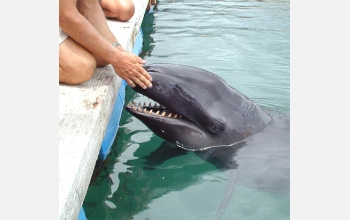Multimedia Gallery
Kina, a false killer whale
Kina, a false killer whale (Pseudorca crassidens) at the Hawaii Institute of Marine Biology, part of the University of Hawaii.
More about this Image
Kina is a 20-year-old false killer whale who is an active participant in ongoing hearing and echolocation research at the Hawaii Institute of Marine Biology, part of the University of Hawaii. Dolphins and whales rely on their acoustic senses for locating prey and for communication with their species. Scientists are concerned about how noise projected into the water from super tankers, oil exploration, navy sonar and oceanographic experiments may effect their acoustic capabilities.
Kina is quite remarkable because thus far, her biosonar--or echolocation--is the best sonar that has ever been tested in the world. She can echolocate and then differentiate between machined cylinders that may differ by as little as .003 of an inch. More specifically, she can tell the difference between cylinders that have a wall-thickness of 250 thousandths of an inch from those that are 247 or 253 thousandths of an inch.
Researchers at the institute are currently examining how well Kina hears while she is echolocating. During echolocation, she produces a loud echolocation click and then immediately receives a very quiet echo back. Researchers found that her auditory system responds to the faint echo at the same magnitude it responds to the loud outgoing click.
Kina is a very mild mannered whale with very large teeth. In the wild, false killer whales hunt in groups and often kill large prey (a large tuna fish for example) and then share it among themselves. In her open bay pen at the institute in Kaneohe Bay, Kina eats herring, smelt and occasionally squid. She is a little shy but learns things very rapidly.
The National Science Foundation supports certain aspects of this ongoing research with marine animals at the institute. Further information about the institute is available on their website Here.
Credit: Karen Pearce, National Science Foundation
Images and other media in the National Science Foundation Multimedia Gallery are available for use in print and electronic material by NSF employees, members of the media, university staff, teachers and the general public. All media in the gallery are intended for personal, educational and nonprofit/non-commercial use only.
Images credited to the National Science Foundation, a federal agency, are in the public domain. The images were created by employees of the United States Government as part of their official duties or prepared by contractors as "works for hire" for NSF. You may freely use NSF-credited images and, at your discretion, credit NSF with a "Courtesy: National Science Foundation" notation.
Additional information about general usage can be found in Conditions.
Also Available:
Download the high-resolution JPG version of the image. (128 KB)
Use your mouse to right-click (Mac users may need to Ctrl-click) the link above and choose the option that will save the file or target to your computer.



 All images in this series
All images in this series